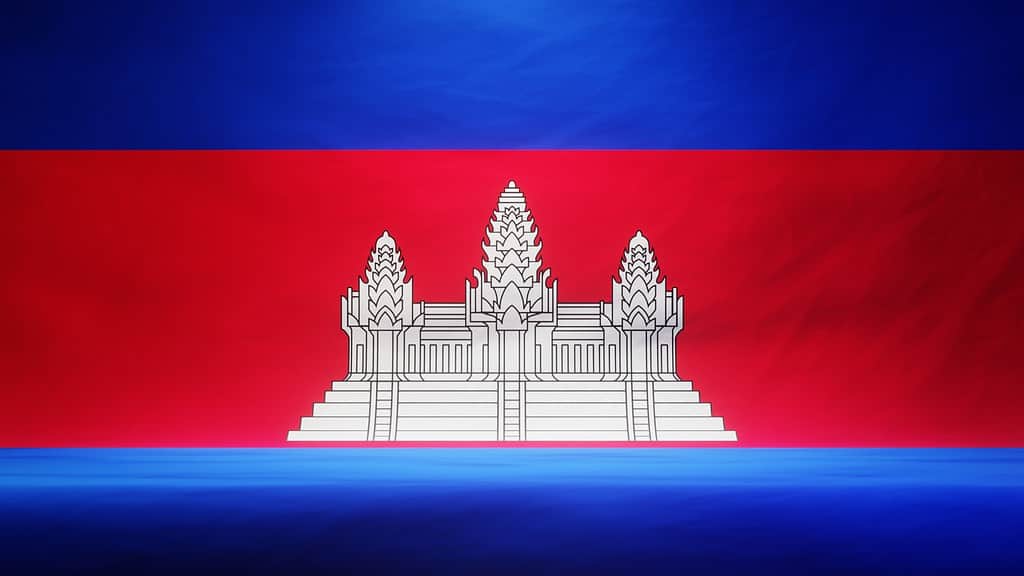After the election of the Constituent Assembly in 1993 and the subsequent restoration of the Cambodian monarchy, the flag of Cambodia, known in Khmer as the Tóngchéat Kampuchea (lit. “National flag of Cambodia”), was re-adopted in its current form.
It’s fitting that the national symbol of Cambodia, the magnificent Angkor Wat, be featured front and center. It is the symbol of national identity and, as the largest religious building in the world, a vital factor in establishing the country’s prominence on the international stage.
In fact, Cambodia is one of just four countries in the world—along with Afghanistan, Spain, and Portugal—whose flag features a prominent image of a building, and that edifice dates back to the 12th century with Angkor Wat. Angkor Wat sits at the center of the current Cambodian flag, which consists of three horizontal bars of blue, red, and blue. Keep reading to learn more about the history, meaning, and symbolism of the flag of Cambodia!
Flag of Cambodia History

The initial Cambodian flag appeared somewhere around 1863.
©iStock.com/EM Concept
1863 – 1948
The initial Cambodian flag appeared somewhere around 1863 and continued to be utilized with minor changes, until 1948 (the period when Cambodia was a French protectorate). There was a white Angkor Wat in the middle of a red landscape with a blue border. This famous temple was built in the 12th century by Mahidharapura monarchs. Since then, five different designs have been deployed. In addition, Angkor Wat was in most of them. However, not all five towers of the temple were represented on those flags.
1948 – 1970
The Angkor Wat was painted white and placed in the middle of a horizontal tricolor flag of blue, red, and blue that was adopted on October 20, 1948. In most depictions, Angkor Wat is denoted by a red outline. This flag has effectively been reinstated as the standard. Before Norodom Sihanouk was deposed in 1970, the country flew this flag. After then, though, it was employed by those in exile and in regions of the country occupied by Sihanouk’s forces.
1970 – 1976
On October 9, 1970, Lon Nol ousted Sihanouk and established a new flag. It had a blue field with a red canton, a white Angkor Wat (depicting only three towers), and three white stars in the upper region of the fly corner. It was used until April 1975.
Cambodia, including Phnom Penh, was under Khmer Rouge rule by April 1975. In addition, the 1948-1970 UN flag was restored through January 1976.
1976 – 1979
From 1976 until 1979, Democratic Kampuchea’s flag was red with a yellow version of Angkor Wat’s three towers. The People’s Republic of Kampuchea was established after the 1979 Vietnamese invasion of Cambodia.
1979 – 1989
The Khmer Rouge administration in Phnom Penh was overthrown in January 1979 after a dissident faction led by Heng Samrin and Hun Sen stormed the country in December 1978 with the help of Vietnamese forces.
The new flag of the People’s Republic of Kampuchea was inspired by the flag used between 1976 and 1979, however, it had five towers rather than three. The country continued to use this flag until 1989 despite it being unrecognized globally.
1989 – 1993
As part of the rebranding to the “State of Cambodia” and the adoption of a new constitution on May 1, 1989, a new flag was also presented. The new flag was a horizontal bicolor of red over blue with a yellow image of Angkor Wat depicting five towers in the center.
1993 – Present
In 1993, the monarchy was restored and the 1948 flag was reintroduced. To be clear, Angkor Wat is no longer traditionally highlighted in red, but rather in black.
Flag of Cambodia Meaning
Design
The Cambodian flag has featured an image of Angkor Wat in its design since at least 1850. Cambodia adopted its present flag after declaring independence in 1948; it contains a blue border, a crimson core region, and also white stripes in the proportions 1:2:1.
The size of the flag is 25 inches long and 16 inches wide. The flag has three colors: two blue stripes on each side of a red stripe. In the middle of the red stripe, which is twice as wide as the blue stripe, is a white picture of Angkor Wat, which is Cambodia’s national symbol. Only this flag and Afghanistan’s flag are mostly made up of pictures of buildings.
Colors
In the middle of the red band is a white, three-tower temple symbolizing Angkor Wat that is outlined in black. The other two bands are blue at the top and blue at the bottom. The colors red and blue have a significant role in the Cambodian flag, as does the depiction of Angkor Wat.
Flag of Cambodia Symbolism

The colors red and blue have a significant role in the Cambodian flag, as does the depiction of Angkor Wat.
©iStock.com/HT Ganzo
The bravery of the Cambodian people, seen so vividly during the conflict, is represented by the color red. Cambodia, whose name means “Cambodia,” uses this color as a symbol. Blue represents the national spirit of freedom, unity, and brotherhood. The crown also serves as a symbol of the country’s monarchy and the King.
As the symbol of national pride and the former capital of the powerful Khmer Empire (which lasted from the 9th to the 15th century), Angkor Wat was an obvious choice for inclusion on the flag. Angkor Wat’s signature white color represents the national religion and philosophy of the country, Buddhism, as well as the cosmological value of purity.
The temple complex of Angkor represents the virtues of honesty, fairness, and Cambodian history. It also plays a significant cultural and spiritual role in the lives of the people here.
The photo featured at the top of this post is © iStock.com/Oleksii Liskonih
Thank you for reading! Have some feedback for us? Contact the AZ Animals editorial team.






